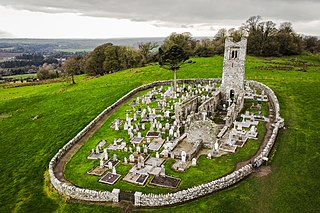
Slane is a village in County Meath, in Ireland. The village stands on a steep hillside on the left bank of the River Boyne at the intersection of the N2 and the N51. As of the 2022 census, Slane's population was 1,445. The village and surrounding area contains many historic sites dating back over 5,000 years. The village centre, as it is laid-out today, dates mainly from the 18th century. The village is in a townland and civil parish of the same name.

Irish round towers are early medieval stone towers of a type found mainly in Ireland, with two in Scotland and one on the Isle of Man. As their name Cloigtheach indicates, they were originally bell towers, though they may have been later used for additional purposes.

Ross Castle is a 15th-century tower house and keep on the edge of Lough Leane, in Killarney National Park, County Kerry, Ireland. It is the ancestral home of the Chiefs of the Clan O'Donoghue, later associated with the Brownes of Killarney.

Trim Castle is a castle on the south bank of the River Boyne in Trim, County Meath, Ireland, with an area of 30,000 m2. Over a period of 30 years, it was built by Hugh de Lacy and his son Walter as the caput of the Lordship of Meath. The Irish Government currently own and are in charge of the care of the castle, through the state agency The Office of Public Works (OPW).

Dundrum Castle, a ruin standing over the town of Dundrum, County Down, Northern Ireland. It was constructed by John de Courcy, sometime near the beginning of the 13th century, following his invasion of Ulster. The castle, built to control access into Lecale from the west and south, stands on the top of a rocky hill commanding fine views south over Dundrum Bay and the Mourne Mountains, the lands west towards Slieve Croob and the plains of Lecale to the east. The Castle is a State Care Historic Monument in the townland of Dundrum, in Newry, Mourne and Down District Council area, at grid ref: J4047 3700.

Naul, is a village, townland, and civil parish at the northern edge of the traditional County Dublin in Ireland. The Delvin River to the north of the village marks the county boundary with County Meath. Naul civil parish is in the historic barony of Balrothery West.

Castletown Geoghegan is a village in County Westmeath, Ireland, and lies south west of Lough Ennell near the county town of Mullingar. It is around 13 km south-west of Mullingar and 19 km north of Tullamore. Castletown was the seat of the Geoghegan family of the medieval Barony of Moycashel in County Westmeath.

Dunasead Castle, sometimes known as Baltimore Castle, is a 17th-century fortified house situated in the town of Baltimore in County Cork, Ireland. The tower house is built on the site of an earlier Norman-era structure, which itself replaced an earlier Bronze Age ringfort. Traditionally associated with the chiefs of clan O'Driscoll, the castle was purchased and restored by members of the McCarthy family in the late 1990s, and partially opened to the public from 2005.

Rockstown Castle is a ruined Irish tower house from medieval times in County Limerick, Ireland. It is located near the village of Ballyneety, 7 miles (11 km) from the city of Limerick.

Dardistown Castle is a castle and country house situated in parkland near Julianstown in County Meath, Ireland a few miles south of Drogheda.

Athclare Castle is a Tudor tower house in the Dunleer area of County Louth in Ireland. Built in the 1550s, Athclare was built for the Barnewell family, and is typical of defensive architectural structures built in the Pale during the Tudor period in Ireland. Athclare has been extended and adapted in the centuries since its construction and is classified as a site of National social historical importance by the Irish National Inventory of Architectural Heritage.

Macroom Castle, in the centre of the town of Macroom, was once residence and fortress of the Lords of Muskerry. The castle has changed owners many times, has been besieged, burned, and rebuilt. The MacCarthys of Muskerry owned it with some interruptions from about 1353 when Muskerry was given to Dermot MacCarthy, 1st Lord of Muskerry, until 1691 when Donogh MacCarthy, 4th Earl of Clancarty lost it definitively.
Inchcleraun, also called Quaker Island, is an island situated in Lough Ree on the River Shannon, in central Ireland.

Kindlestown Castle is a ruined hall house-style castle and a National Monument in Delgany, Ireland.

Athlumney Castle is a tower house and fortified house and a National Monument in Navan, Ireland.

Dunmoe Castle is a castle and National Monument located near Navan, Ireland.

Roscrea Castle is a 13th-century motte-and-bailey castle in the town of Roscrea, Ireland. The castle consists of a walled courtyard, gate block, and angled towers. Along with 18th century Damer House and gardens, the castle forms part of Roscrea Heritage Centre.

Athenry Castle is a tower house and National Monument located in Athenry, Ireland.

Kilgobbin Castle is a 15th-century tower house in Dublin, Ireland.





















